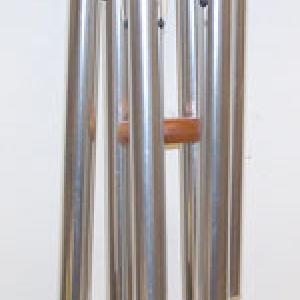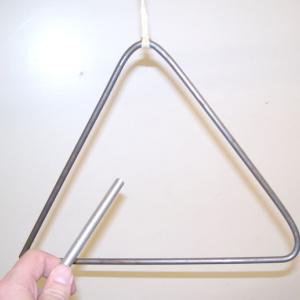College of Liberal Arts & Sciences
3D40.60 - Chimes/Triangle
See Also: 3B39.30 - "Big Ben - Coat Hanger on a String" entry.
Hang the triangle or chime by a string and strike with the mallet. A large sound that rings for several seconds should be produced.
- Dan MacIsaac, "'Say it with Chimes: An Engineering Approach to Wind Chime Design,' by Lee Hite", TPT, Vol. 56, #9, Dec. 2018, p. 654.
- Douglas L. Oliver, "Two Simple and Inexpensive Desk-Top Experiment with Vibrations of a Uniform Beam", TPT, Vol. 56, #8, Nov. 2018, p. 548.
- Kyle Forinash, "Pitch and Frequency", TPT, Vol. 38, #6, Sept. 2000, p. 328.
- Robert W. Harris, "Using Wind Chimes to Introduce the Physics Course", TPT, Vol. 38, #4, Apr. 2000, p. 218.
- Garry Kvistad, "Pleasant Music from Wind Chimes", TPT, Vol. 36, #6, Sept. 1998, p. 325.
- G. William Baxter and Keith M. Hagenbuch, "Correction: 'A Student Project on Wind Chimes. Tuning in to Standing Waves'", TPT, Vol. 36, #5, May 1998, p. 260.
- D. L. R. Oliver, "Hollow-Tube Chimes", TPT, Vol. 36, #4, Apr. 1998, p. 209.
- G. William Baxter and Keith M. Hagenbuch, "A Student Project on Wind Chimes. Tuning in to Standing Waves", TPT, Vol. 36, #4, Apr. 1998, p. 204.
- Kyle Forinash, John P. Richie, Jr., and Tim Jones, "Wind Chime Physics", AJP, Vol. 58, #1, Jan. 1990, p. 82.
- Charles Vivian, "The Roaring Ruler", Science Experiments & Amusements For Children, p. 86.
- Charles Vivian, "A Path for Sound", Science Experiments & Amusements For Children, p. 39.
- Martin Gardner, "Coat-Hanger Chimes", Entertaining Science Experiments with Everyday Objects, p. 121.
- Thomas J. Senior, Richard Heckathorn, and Gordon Shepherd, "Conduit Pipes Email", May 15, 2006.
Disclaimer: These demonstrations are provided only for illustrative use by persons affiliated with The University of Iowa and only under the direction of a trained instructor or physicist. The University of Iowa is not responsible for demonstrations performed by those using their own equipment or who choose to use this reference material for their own purpose. The demonstrations included here are within the public domain and can be found in materials contained in libraries, bookstores, and through electronic sources. Performing all or any portion of any of these demonstrations, with or without revisions not depicted here entails inherent risks. These risks include, without limitation, bodily injury (and possibly death), including risks to health that may be temporary or permanent and that may exacerbate a pre-existing medical condition; and property loss or damage. Anyone performing any part of these demonstrations, even with revisions, knowingly and voluntarily assumes all risks associated with them.

